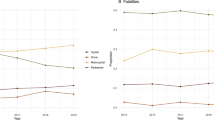Abstract
With an increasing percentage of the global population living in cities and the concurrent decrease in physical activity in daily life, public health issues for urban development have arisen. This study responds to that trend by presenting an approach to measure city-wide physical activity levels. Comparing of city indices for active sports and the active transportation shows differences between subject cities and activity level of age groups in sports as well as walking and cycling. Therefore, our study lends itself to implications for urban development towards creating a healthier city.

Similar content being viewed by others
Notes
As an update to the IPAQ, we set the MET value for walking for transportation to 3.7 and the MET value for cycling for transportation to 5.4. The 2011 Compendium of Physical Activities has updated the MET values in comparison to the scoring method of the IPAQ from 2005. Walking for transport represents the mean of walking for pleasure (3.5), walking for transportation 2.8–3.2 mph, level, moderate pace, firm surface (3.5), and walking, to work or class (4.0). Cycling for transport represents the mean of bicycling, <10 mph, leisure, to work or for pleasure (4.0) and bicycling, to/from work, self-selected pace (6.8).
References
Edwards P, Tsouros AD. A healthy city is an active city: a physical activity planning guide. Copenhagen: Denmark; WHO Regional Office for; 2008.
Cavill N, Kahlmeier S, Racioppi F. Physical activity and health in Europe: evidence for action. Copenhagen: Denmark; WHO Regional Office for; 2006.
Abu-Omar K, Rütten A. Sport oder körperliche Aktivität. Bundesgesundheitsbl Gesundheitsforsch Gesundheitsschutz. 2006; 49(11): 1162–1168.
Vlanhov D, Freudenberg N, Proietti F, et al. Urban as a determinant of health. J Urban Health. 2007; 84(1): 16–26.
WHO (2010). Global recommendations on physical activity for health. WHO; 2010. http://whqlibdoc.who.int/publications/2010/9789241599979_eng.pdf. Accessed 17 Jul 2013.
United Nations. World urbanization prospects: the 2011 revision. United Nations, Department of Economic and Social Affairs, Population Division; 2012 CD-ROM Edition.
Statterthwaite D. Will most people live in cities? BJM. 2000; 321(4): 1143–1145.
Duhl LJ, Sanchez AK. Healthy cities and the city planning process: a background document on links between health and urban planning. WHO Regional Office for Europe; 1999. http://www.euro.who.int/document/e67843.pdf. Accessed 31 May 2013.
Caspersen CJ, Powell KE, Christenson GM. Physical activity, exercise, and physical fitness: definitions and distinctions for health-related research. Public Health Rep. 1985; 100(2): 126–131.
Foster C. Guidelines for health-enhancing physical activity promotion programmes. HEPA Network; 2000. www.panh.ch/hepaeurope/materials/Guidelines%20HEPA%20Europe.pdf. Accessed 17 Jul 2013.
Mensink G. Beiträge zur Gesundheitsberichterstattung des Bundes - Bundes-Gesundheitssurvey: Körperliche Aktivität. Robert Koch-Institut; 2003. http://www.rki.de/DE/Content/Gesundheitsmonitoring/Gesundheitsberichterstattung/GBEDownloadsB/koerperliche_aktivitaet.pdf?__blob=publicationFile. Accessed 17 July 2013.
Horn M, Gans P. Sport als Wirtschafts-und Standortfaktor. Geogr Rundsch. 2012; 16(5): 4–10.
Bale J. Sports geography. 2nd ed. London: England; Routledge; 2003.
Steinhardt M, Völpel H. Champions des Sports 2008 – Ein empirischer Vergleich deutscher Sportstädte. HWWi Policy Paper 1–9. 2008. http://www.hwwi.org/uploads/tx_wilpubdb/HWWI_Policy_Paper_1-9.pdf. Accessed 17 July 2013.
Sjöström M, Oja P, Hagströmer M, Smith BJ, Baumann A. Health-enhancing physical activity across European Union countries: the Europarometer study. J Public Health. 2006; 83(2): 291–300.
Ainsworth BE, et al. Compendium of physical activities: a second update of codes and MET values. Med Sci Sports Exerc. 2011; 43(8): 1575–1581.
Gabler S, Häder S. Erfahrungen beim Aufbau eines Auswahlverfahrens für Telefonstichproben in Deutschland. ZUMA-Nachr. 1999; 44(1): 45–61.
Daumann F, Heinze R, Römmelt B. Veränderungen der Sportmotive im Lebenslauf - Grundlage eines mitgliederorientierten Managements im Sportverein. Vortrag zur 17. Jahrestagung des Arbeitskreises Sportökonomie e.V. vom 03. - 04.05.2013 in München zum Thema “Evolution und Revolution im Sport”. Schorndorf: Germany; Arbeitskreises Sportökonomie e.V.; 2013.
Pan SY, Cameron C, DesMeules M, Morrison H, Craig CL, Jiang X. Individual, social, environmental, and physical environmental correlates with physical activity among Canadians: a cross-sectional study. BMC Public Health. 2009; 9: 21. doi:10.1186/1471-2458-9-21.
Humpel N, Owen N, Leslie E. Environmental factors associated with adults’ participation in physical activity. Am J Prev Med. 2002; 22(3): 188–199.
Brawley LR, Rejeski WJ, King AC. Promoting physical activity for older adults. Am J Prev Med. 2003; 25(3Sii): 172–183.
Pikora T, Giles-Corti B, Bull F, Jamrozik K, Donovan R. Developing a framework for assessment of the environmental determinants of waling and cycling. Soc Sci Med. 2003; 56(8): 1693–1703.
Stroneggar WJ, Titze S, Oja P. Perceived characteristics of the neighborhood and its association with physical activity behavior and self-rated health. Health & Place. 2010; 16(4): 736–743.
Heath WG, Parra DC, Sarmiento OL, et al. Evidence-based intervention in physical activity: lessons from around the world. Lancet. 2012; 380(9838): 272–281.
Merom D, Baumann A, Vita P, Close G. An environmental intervention to promote walking and cycling—the impact of a newly constructed Rail Trail in Western Sydney. Prev Med. 2003; 36(2): 235–242.
Smith KL, Carr K, Wisemann A, Calhoun K, McNevin NH, Weir PL. Barriers are not the limiting factor to participation in physical activity in Canadian seniors. J Aging Res. 2012. doi:10.1155/2012/890679.
Hu G, Sarti C, Jousilahti P, Silventoinen K, Barengo NC, Tuomilehto J. Leisure time, occupational, and commuting physical activity and the risk of stroke. Stroke. 2005; 36(9): 1994–1999.
Acknowledgment
The authors gratefully thank Mr. Thomas Ritter from the CATI-Laboratory of the University of Jena (Germany) for his support and the whole data collection team. This study was conducted without any third-party research grants.
Author information
Authors and Affiliations
Corresponding author
Rights and permissions
About this article
Cite this article
Daumann, F., Heinze, R., Römmelt, B. et al. An Active City Approach for Urban Development. J Urban Health 92, 217–229 (2015). https://doi.org/10.1007/s11524-014-9929-9
Published:
Issue Date:
DOI: https://doi.org/10.1007/s11524-014-9929-9




